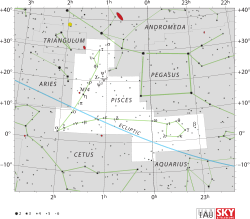Upsilon Piscium
Upsilon Piscium is a solitary,[10] white-hued star in the zodiac constellation of Pisces. It is faintly visible to the naked eye, having an apparent visual magnitude of +4.75.[2] Based upon an annual parallax shift of 10.59 mas as seen from Earth,[1] it is located about 308 light years from the Sun. The star is drifting further away with a heliocentric radial velocity of +6 km/s.[4]
 | |
| Observation data Epoch J2000.0 Equinox J2000.0 (ICRS) | |
|---|---|
| Constellation | Pisces |
| Right ascension | 01h 19m 27.99289s[1] |
| Declination | +27° 15′ 50.6155″[1] |
| Apparent magnitude (V) | 4.752[2] |
| Characteristics | |
| Spectral type | A3 V[3] |
| U−B color index | +0.10[2] |
| B−V color index | +0.03[2] |
| Astrometry | |
| Radial velocity (Rv) | +5.8±2.7[4] km/s |
| Proper motion (μ) | RA: +22.98[1] mas/yr Dec.: −11.12[1] mas/yr |
| Parallax (π) | 10.59 ± 0.25[1] mas |
| Distance | 308 ± 7 ly (94 ± 2 pc) |
| Absolute magnitude (MV) | −0.13[5] |
| Details | |
| Mass | 2.84±0.05[3] M☉ |
| Radius | 2.2[6] R☉ |
| Luminosity | 117[3] L☉ |
| Surface gravity (log g) | 3.59[7] cgs |
| Temperature | 9,183±312[7] K |
| Metallicity [Fe/H] | +0.00±0.05[8] dex |
| Rotational velocity (v sin i) | 91[3] km/s |
| Age | 461[7] Myr |
| Other designations | |
| Database references | |
| SIMBAD | data |
This is an ordinary A-type main sequence star with a stellar classification of A3 V.[3] It is 461[7] million years old – about 98% of the way through its main sequence lifetime[3] – and is spinning with a projected rotational velocity of 91 km/s.[3] The star has 2.8[3] times the mass of the Sun, about 2.2[6] times the Sun's radius, and is radiating 117[3] times the Sun's luminosity from its photosphere at an effective temperature of 9183 K.[7]
Naming
υ Piscium is the Bayer designation for this star, which is Latinized as Upsilon Piscium. It has the Flamsteed designation 90 Piscium.[9]
In Chinese, 奎宿 (Kuí Sù), meaning Legs (asterism), refers to an asterism composed of υ Piscium, η Andromedae, 65 Piscium, ζ Andromedae, ε Andromedae, δ Andromedae, π Andromedae, ν Andromedae, μ Andromedae, β Andromedae, σ Piscium, τ Piscium, 91 Piscium, φ Piscium, χ Piscium and ψ¹ Piscium. Consequently, the Chinese name for υ Piscium itself is 奎宿十三 (Kuí Sù shí sān, English: the Thirteenth Star of Legs.)[11]
References
- van Leeuwen, F. (2007), "Validation of the new Hipparcos reduction", Astronomy and Astrophysics, 474 (2): 653–664, arXiv:0708.1752, Bibcode:2007A&A...474..653V, doi:10.1051/0004-6361:20078357.
- Johnson, H. L.; et al. (1966), "UBVRIJKL photometry of the bright stars", Communications of the Lunar and Planetary Laboratory, 4 (99), Bibcode:1966CoLPL...4...99J.
- Zorec, J.; Royer, F. (January 2012), "Rotational velocities of A-type stars. IV. Evolution of rotational velocities", Astronomy & Astrophysics, 537: A120, arXiv:1201.2052, Bibcode:2012A&A...537A.120Z, doi:10.1051/0004-6361/201117691.
- de Bruijne, J. H. J.; Eilers, A.-C. (October 2012), "Radial velocities for the HIPPARCOS-Gaia Hundred-Thousand-Proper-Motion project", Astronomy & Astrophysics, 546: 14, arXiv:1208.3048, Bibcode:2012A&A...546A..61D, doi:10.1051/0004-6361/201219219, A61.
- Anderson, E.; Francis, Ch. (2012), "XHIP: An extended hipparcos compilation", Astronomy Letters, 38 (5): 331, arXiv:1108.4971, Bibcode:2012AstL...38..331A, doi:10.1134/S1063773712050015.
- Pasinetti Fracassini, L. E.; et al. (February 2001), "Catalogue of Apparent Diameters and Absolute Radii of Stars (CADARS)", Astronomy and Astrophysics (Third ed.), 367: 521–524, arXiv:astro-ph/0012289, Bibcode:2001A&A...367..521P, doi:10.1051/0004-6361:20000451.
- David, Trevor J.; Hillenbrand, Lynne A. (2015), "The Ages of Early-Type Stars: Strömgren Photometric Methods Calibrated, Validated, Tested, and Applied to Hosts and Prospective Hosts of Directly Imaged Exoplanets", The Astrophysical Journal, 804 (2): 146, arXiv:1501.03154, Bibcode:2015ApJ...804..146D, doi:10.1088/0004-637X/804/2/146.
- Morossi, C.; et al. (September 2002), "Metallicity Determinations from Ultraviolet-Visual Spectrophotometry. I. The Test Sample", The Astrophysical Journal, 577 (1): 377–388, Bibcode:2002ApJ...577..377M, doi:10.1086/342144.
- "ups Psc". SIMBAD. Centre de données astronomiques de Strasbourg. Retrieved 2017-07-24.
- Eggleton, P. P.; Tokovinin, A. A. (September 2008), "A catalogue of multiplicity among bright stellar systems", Monthly Notices of the Royal Astronomical Society, 389 (2): 869–879, arXiv:0806.2878, Bibcode:2008MNRAS.389..869E, doi:10.1111/j.1365-2966.2008.13596.x.
- (in Chinese) AEEA (Activities of Exhibition and Education in Astronomy) 天文教育資訊網 2006 年 5 月 19 日